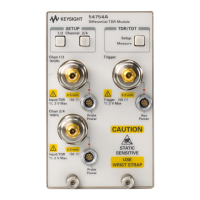Transmission Line Theory Applied to Digital Systems
Transmission Line Design
11-3
Microstrip and strip lines may be treated as operating in the transverse electro-
magnetic (TEM) mode. Although microstrip propagation is not purely TEM
because of non-uniform dielectrics, for all practical purposes it can be treated
as TEM. The characteristic impedance of the line is:
and the propagation delay is:
For a homogeneous medium the propagation delay is also equal to:
Where µ is the permeability and ε is the permittivity of the medium. In
transmission lines, the relative permeability (µ
r
) is unity,
µ
o
= 4π × 10
-7
henries/metre, and ε
o
= 8.85 x 10
-12
farads/metre.
Therefore, t
pd
= 1.017 ns/ft, ε
r
is the relative dielectric constant. For microstrip
lines on glass epoxy boards ε
r
= 3.0, and for strip lines ε
r
= 5.0.
From transmission line theory for a lossless line, it can be shown that a signal
sent down a line of constant characteristic impedance will travel along the line
without distortion. However, when the signal reaches the end of the line, a
reflection will occur if the line is not properly terminated. Proper termination
requires the terminator value to be equal to the characteristic impedance of the
line.
Figure 11-2 shows a MECL gate driving a transmission line terminated in a load
resistor, R
L
. A negative-going transition on the input to the gate will result in
a positive-going transition at the NOR output. The MECL gate is essentially a
VHF linear differential amplifier with a bandwidth of 0.37 ÷ t
r
(MHz), where t
r
is the risetime of the gate in nanoseconds. The effect of the capacitance of the
transmission line will not decrease the bandwidth or affect the risetime at the
MECL gate output. However, the signal at the end of a long transmission line
may be attenuated due to bandwidth limitations in the particular type of
transmission line used. For the purposes of this discussion, a long line is defined
as a line having a propagation delay larger than the risetime of the driving circuit
divided by two: T
D
> t
r
÷ 2.
Z
o
L
o
C
o
⁄
=
t
pd
L
o
C
o
Z
o
C
o
==
t
pd
µε µ
o
µ
r
ε
o
ε
r
==

